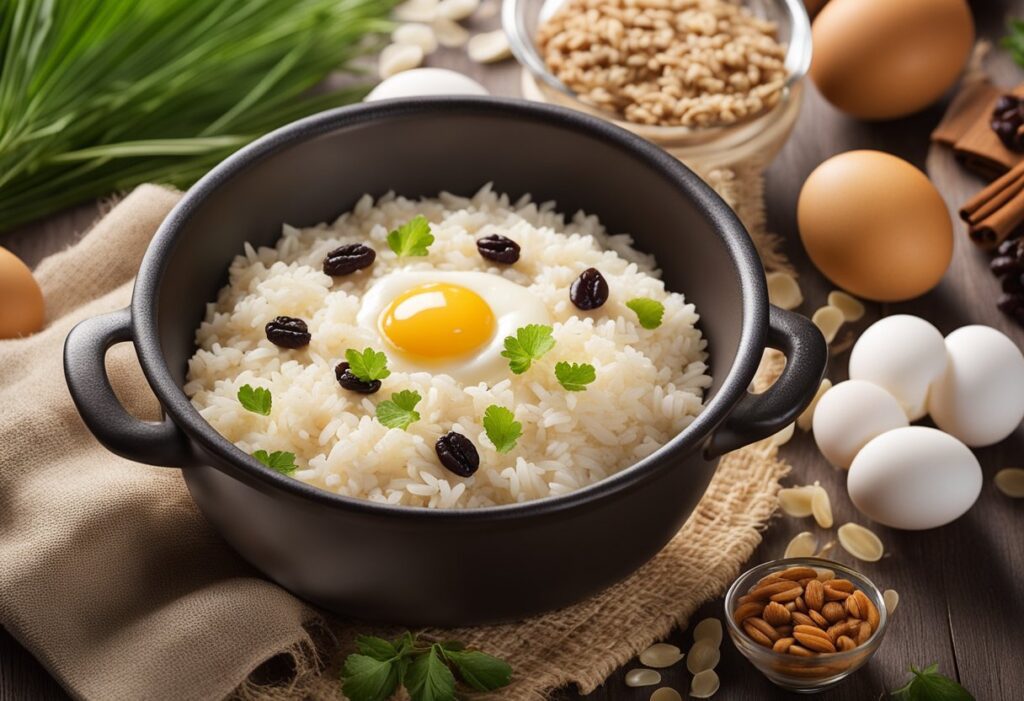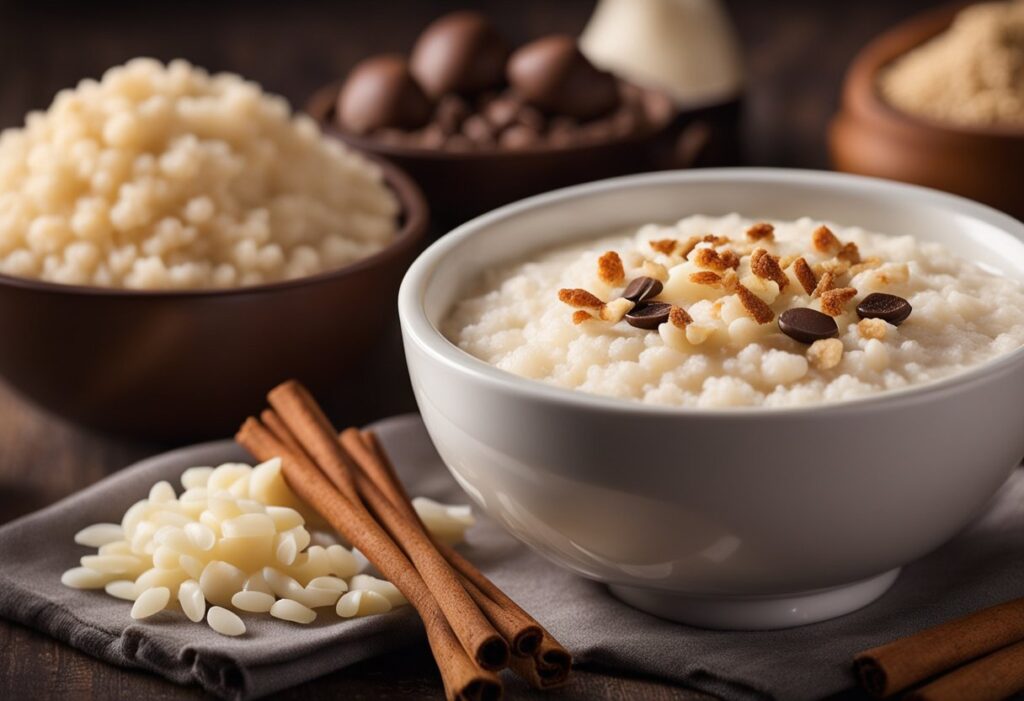Rice pudding is a classic dessert that has been enjoyed for centuries. It is a simple yet satisfying dish that can be made with just a few ingredients. The recipe for rice pudding varies from region to region, with each culture adding its own unique twist to the dish.
Table of Contents
One of the great things about rice pudding is its versatility. It can be served hot or cold, and can be flavored with a variety of ingredients such as cinnamon, vanilla, or nutmeg. The texture of the pudding can also be adjusted to suit individual preferences, with some people preferring a thick and creamy consistency while others prefer a lighter, more soupy texture.
Despite its simplicity, rice pudding has a rich history and has been enjoyed by people all around the world for generations. Whether you are looking for a comforting dessert to enjoy on a cold winter night or a light and refreshing treat to cool off on a hot summer day, rice pudding is the perfect choice. With its creamy texture and delicious flavor, it is sure to please even the most discerning palate.
History of Rice Pudding
Rice pudding is a classic dessert that has been enjoyed by people around the world for centuries. Its origins can be traced back to ancient China, where rice was a staple food. The Chinese would cook rice in milk and sweeten it with honey, creating a dish that was similar to the rice pudding we know today.
Over time, rice pudding spread to other parts of the world. In Europe, it became a popular dessert during the Middle Ages, when rice was introduced to the continent by the Moors. The dish was often flavored with spices such as cinnamon and nutmeg, and was sometimes served with fruit or nuts.
In the United States, rice pudding became a popular dessert during the 19th century. It was often served in boarding houses and other establishments that catered to travelers. The dish was also a favorite of sailors, who would bring rice and other ingredients on long voyages.
Today, rice pudding is enjoyed in many different forms around the world. In India, for example, it is often flavored with cardamom and served as a breakfast dish. In Scandinavia, it is sometimes served cold with a dollop of lingonberry jam. And in the United States, it is often flavored with vanilla and served warm with a sprinkle of cinnamon.
Despite its many variations, rice pudding remains a beloved dessert that has stood the test of time. Whether served hot or cold, plain or flavored, it is a comforting and satisfying dish that continues to delight people of all ages.
Essential Ingredients

When it comes to making a delicious rice pudding, there are a few essential ingredients that are necessary to achieve the perfect texture and flavor. Here are the key ingredients you’ll need:
Rice
As the name suggests, rice is the star of the show when it comes to rice pudding. Short-grain rice varieties, such as Arborio or sushi rice, are the best choices for rice pudding. These types of rice have a higher starch content, which helps to create a creamy and thick pudding.
Milk
Milk is another essential ingredient in rice pudding. Whole milk is the best choice, as it has a higher fat content that contributes to the pudding’s creaminess. However, you can also use low-fat milk or a combination of milk and cream for a richer flavor.
Sugar
Sugar is necessary to sweeten the pudding and balance out the flavors. White granulated sugar is the most common choice, but you can also use brown sugar or honey for a different flavor profile.
Flavorings
There are many different flavorings you can add to rice pudding to make it your own. Vanilla extract is a classic choice, but you can also experiment with cinnamon, nutmeg, cardamom, or even citrus zest.
Optional Add-ins
While not essential, adding in some extra ingredients can take your rice pudding to the next level. Raisins, chopped nuts, or dried fruit are all popular choices. You can also try adding in a spoonful of jam or jelly for a burst of flavor.
Overall, with these essential ingredients and some creativity, you can make a delicious and comforting rice pudding that will satisfy any sweet tooth.
Recommended Equipment
Cooking Vessels
When it comes to making rice pudding, having the right cooking vessel can make all the difference. A heavy-bottomed pot or saucepan is ideal for even heat distribution and preventing the mixture from sticking to the bottom. A non-stick pot can also be used, but it’s important to avoid using metal utensils that can scratch the surface.
Measuring Tools
Accurate measurements are crucial when making rice pudding, so it’s important to have reliable measuring tools. A set of measuring cups and spoons is essential for measuring ingredients such as rice, milk, sugar, and spices. A kitchen scale can also be useful for measuring ingredients by weight, especially when working with larger quantities.
Mixing Utensils
To ensure a smooth and creamy rice pudding, it’s important to use the right mixing utensils. A whisk is ideal for incorporating the ingredients and preventing lumps from forming. A silicone spatula can also be useful for scraping the sides of the pot and ensuring all of the ingredients are well combined.
Overall, having the right equipment can make the process of making rice pudding much easier and more enjoyable. By using the recommended cooking vessels, measuring tools, and mixing utensils, anyone can create a delicious and satisfying dessert that is sure to impress.
Preparation Basics

Rinsing Rice
Before cooking rice pudding, it is important to rinse the rice thoroughly to remove any excess starch. This will prevent the rice from becoming too sticky and clumpy. To rinse the rice, place it in a fine-mesh strainer and rinse it under cold running water until the water runs clear. This should take about 2-3 minutes. Once the rice is rinsed, allow it to drain for a few minutes before using it in the recipe.
Soaking Rice
Soaking the rice before cooking it can help to ensure that it cooks evenly and results in a creamy, smooth texture. To soak the rice, place it in a bowl and cover it with cold water. Allow the rice to soak for at least 30 minutes, or up to 2 hours. After soaking, drain the rice and rinse it again before using it in the recipe.
When preparing rice pudding, it is important to follow these basic preparation steps to ensure the best possible result. By rinsing and soaking the rice, you can help to prevent the rice from becoming too sticky or clumpy, and ensure that it cooks evenly and results in a creamy, smooth texture.
Cooking Techniques
Stovetop Method
The stovetop method is the traditional way of making rice pudding. It involves cooking rice in milk and sugar on low heat until it thickens and becomes creamy. To make rice pudding using the stovetop method, follow these steps:
- Rinse the rice and add it to a pot with water. Bring to a boil and let it cook for 10 minutes.
- Drain the rice and add it back to the pot with milk and sugar. Stir well.
- Cook the mixture on low heat, stirring occasionally, for 30-40 minutes until the rice is soft and the pudding is thick and creamy.
- Remove from heat and let it cool for a few minutes before serving.
Oven-Baked Method
The oven-baked method is another way to make rice pudding. It involves baking the rice in milk and sugar in the oven until it thickens and becomes creamy. To make rice pudding using the oven-baked method, follow these steps:
- Preheat the oven to 350°F (175°C).
- Rinse the rice and add it to a baking dish with milk and sugar. Stir well.
- Cover the dish with foil and bake for 45-50 minutes.
- Remove the foil and bake for another 15-20 minutes until the pudding is thick and creamy.
- Remove from the oven and let it cool for a few minutes before serving.
Instant Pot Method
The Instant Pot method is the quickest way to make rice pudding. It involves cooking rice in milk and sugar in an Instant Pot until it thickens and becomes creamy. To make rice pudding using the Instant Pot method, follow these steps:
- Rinse the rice and add it to the Instant Pot with milk, sugar, and cinnamon. Stir well.
- Close the lid and set the Instant Pot to manual mode for 10 minutes.
- Let the pressure release naturally for 10 minutes, then release any remaining pressure manually.
- Open the lid and stir the pudding well.
- Let it cool for a few minutes before serving.
Flavor Variations

Sweet Versions
Rice pudding is a classic dessert that can be enjoyed in a variety of ways. While the traditional recipe calls for vanilla and cinnamon, there are many other sweet variations that can be made. Some popular options include:
- Chocolate: add cocoa powder or melted chocolate to the pudding for a rich and decadent chocolate flavor.
- Fruit: stir in fresh or canned fruit, such as strawberries, peaches, or pineapple, for a fruity twist.
- Coconut: use coconut milk instead of regular milk and top with toasted coconut flakes for a tropical flavor.
- Honey: sweeten the pudding with honey instead of sugar for a natural and floral taste.
Savory Twists
Rice pudding doesn’t have to be just a dessert. It can also be turned into a savory dish by adding different ingredients and spices. Here are some ideas to try:
- Curry: add curry powder, turmeric, and vegetables, such as peas and carrots, for a savory and spicy Indian-inspired rice pudding.
- Parmesan: stir in grated Parmesan cheese, garlic, and herbs, such as thyme and rosemary, for a cheesy and savory rice pudding.
- Mushroom: sauté mushrooms and onions and mix them into the pudding with a sprinkle of thyme and black pepper for a savory and earthy flavor.
- Bacon: cook bacon until crispy and crumble it on top of the pudding with a drizzle of maple syrup for a sweet and savory breakfast option.
Overall, rice pudding can be a versatile dish that can be customized to suit any taste. With these flavor variations, there’s no need to stick to the traditional recipe.
Serving Suggestions
Rice pudding is a versatile dessert that can be served in many ways. Here are some ideas to help you make the most of your rice pudding:
- Fruit toppings: Fresh or canned fruits can be used to add some color and flavor to your rice pudding. Some popular options include strawberries, blueberries, and peaches.
- Nuts and seeds: Chopped nuts, such as almonds, pecans, or walnuts can add a crunchy texture to your rice pudding. You can also sprinkle some seeds, such as chia or flax seeds, for added nutrition.
- Spices: Cinnamon, nutmeg, and cardamom are some of the spices that can be used to flavor your rice pudding. You can also add a pinch of salt to enhance the flavors.
- Whipped cream: A dollop of whipped cream on top of your rice pudding can add a creamy and luxurious touch to your dessert.
- Chocolate chips: For those with a sweet tooth, adding some chocolate chips to your rice pudding can be a decadent treat.
- Ice cream: Serving your rice pudding with a scoop of ice cream can be a fun and delicious way to enjoy this dessert.
Overall, rice pudding is a dessert that can be customized to suit your taste preferences. Whether you prefer it warm or cold, plain or with toppings, there are endless possibilities to enjoy this classic dessert.
Storage and Preservation
After making a delicious batch of rice pudding, it is important to store it properly to ensure it stays fresh and tasty for as long as possible. Here are some tips on how to store and preserve your rice pudding:
- Refrigerate: Rice pudding should be stored in an airtight container in the refrigerator. It can last up to 5 days in the fridge.
- Freeze: If you have a large batch of rice pudding, you can freeze it for later. Simply place it in an airtight container and freeze for up to 3 months. Thaw it in the fridge overnight before reheating.
- Reheat: To reheat rice pudding, place it in a saucepan over low heat and stir constantly until heated through. You can also reheat it in the microwave, but be sure to stir it every 30 seconds to prevent it from becoming too hot.
- Avoid contamination: Always use clean utensils and containers when handling rice pudding. Do not leave it at room temperature for too long, as this can cause bacteria to grow.
By following these simple tips, you can ensure that your rice pudding stays fresh and delicious for as long as possible.
Common Mistakes to Avoid
When making rice pudding, there are a few common mistakes that can easily be avoided to ensure a delicious and creamy end result. Here are some tips to help you avoid these pitfalls:
Using the Wrong Rice
One of the most common mistakes people make when making rice pudding is using the wrong type of rice. Long-grain rice, such as jasmine or basmati, is not suitable for making rice pudding. Instead, you should use short-grain rice, such as Arborio or sushi rice. These types of rice are high in starch and will help give your pudding a creamy texture.
Not Rinsing the Rice
Before cooking the rice, it is important to rinse it thoroughly to remove any excess starch. Failure to do so can result in a gummy and sticky pudding. Rinse the rice under cold running water until the water runs clear.
Overcooking the Rice
Overcooking the rice is another common mistake that can ruin your rice pudding. The rice should be cooked until it is tender but still holds its shape. If you overcook the rice, it will become mushy and the pudding will lose its texture.
Not Adding Enough Liquid
Rice pudding should have a creamy and smooth texture, which means you need to add enough liquid. If you don’t add enough liquid, the pudding will be dry and lumpy. The ratio of liquid to rice should be around 2:1.
Not Stirring the Pudding
Stirring the pudding is essential to ensure that the rice cooks evenly and that the pudding has a smooth texture. If you don’t stir the pudding, the rice will stick to the bottom of the pan and burn. Stir the pudding frequently, especially towards the end of the cooking time.
By avoiding these common mistakes, you can make a delicious and creamy rice pudding that will be a hit with your family and friends.

